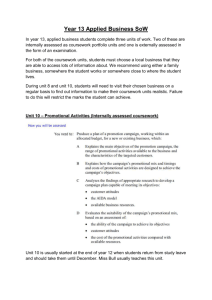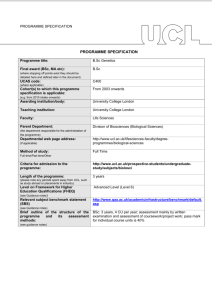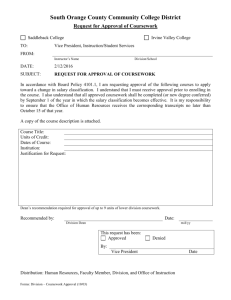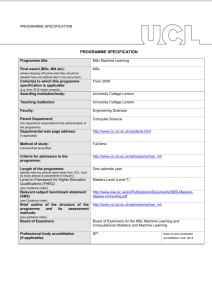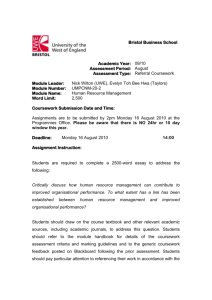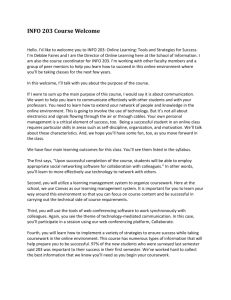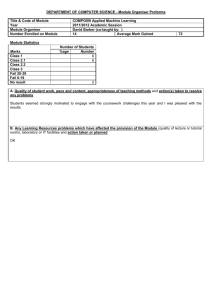BSc Statistics, Economics and a Language
advertisement
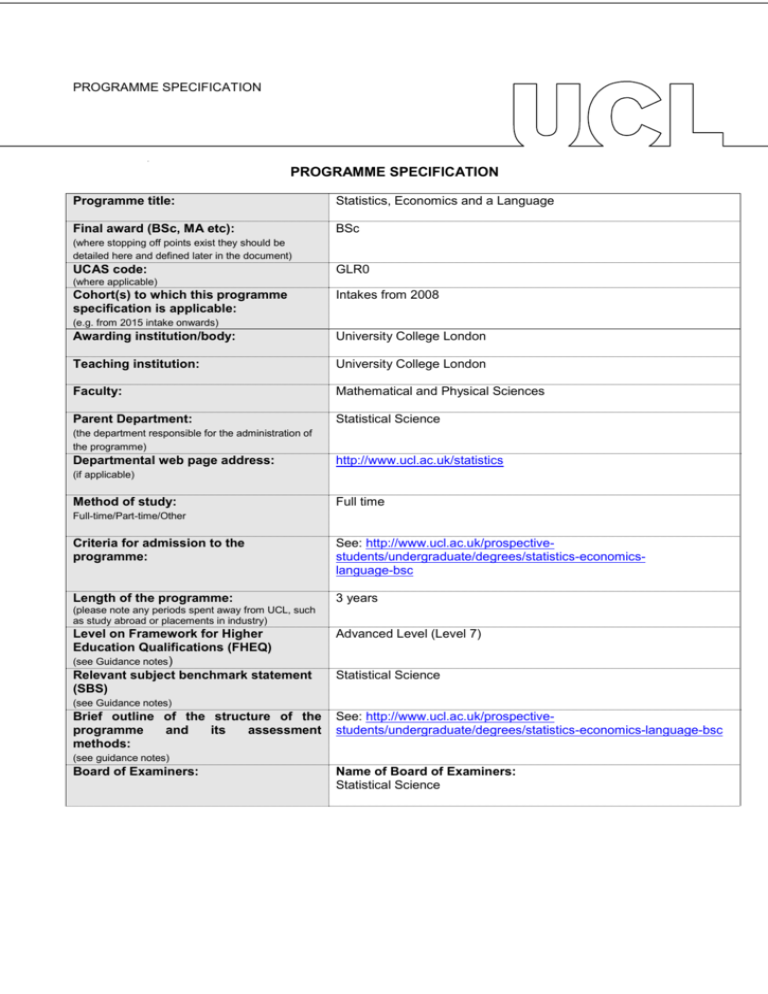
PROGRAMME SPECIFICATION PROGRAMME SPECIFICATION Programme title: Statistics, Economics and a Language Final award (BSc, MA etc): BSc (where stopping off points exist they should be detailed here and defined later in the document) UCAS code: GLR0 (where applicable) Cohort(s) to which this programme specification is applicable: Intakes from 2008 (e.g. from 2015 intake onwards) Awarding institution/body: University College London Teaching institution: University College London Faculty: Mathematical and Physical Sciences Parent Department: Statistical Science (the department responsible for the administration of the programme) Departmental web page address: http://www.ucl.ac.uk/statistics (if applicable) Method of study: Full time Full-time/Part-time/Other Criteria for admission to the programme: See: http://www.ucl.ac.uk/prospectivestudents/undergraduate/degrees/statistics-economicslanguage-bsc Length of the programme: 3 years (please note any periods spent away from UCL, such as study abroad or placements in industry) Level on Framework for Higher Education Qualifications (FHEQ) (see Guidance notes) Relevant subject benchmark statement (SBS) Advanced Level (Level 7) Statistical Science (see Guidance notes) Brief outline of the structure of the programme and its assessment methods: See: http://www.ucl.ac.uk/prospectivestudents/undergraduate/degrees/statistics-economics-language-bsc (see guidance notes) Board of Examiners: Name of Board of Examiners: Statistical Science Professional body accreditation (if applicable): Royal Statistical Society Date of next scheduled accreditation visit: renewed annually EDUCATIONAL AIMS OF THE PROGRAMME: To provide an intellectually challenging undergraduate degree programme in quantitative methods, together with a basic knowledge of Economics and a reasonable ability to communicate in a second language in addition to English. This training should enable students to profit from the general numeracy, reasoning and linguistic skills acquired during the programme in order to take up trainee positions in accountancy, finance, insurance or management, or to proceed to positions as Statisticians in industry, commerce or public organisations. The study of a second language recognises that increasingly these careers have an international dimension. Students should be able to converse reasonably fluently (according to the level) with native speakers and discuss personal, social, current and professional issues using appropriate structures. The programme should also provide a preparation for a Master's programme in Statistics or Economics, which in turn is a normal requirement for postgraduate research in either of these areas. Via appropriate choice of options, the programme may also provide a foundation for a career, or for further study, in Operational Research. PROGRAMME OUTCOMES: The programme provides opportunities for students to develop and demonstrate knowledge and understanding, qualities, skills and other attributes in the following areas: A: Knowledge and understanding Knowledge and understanding of: 1. fundamental ideas of probability theory and applied probability; 2. appropriate methods of statistical inference, in a variety of standard situations and over a range of applied areas; 3. a statistical computer package; 4. fundamentals of microeconomics and macroeconomics, together with topics in either finance or econometrics; 5. mathematical methods associated with 1, 2 and 4 above; 6. the structure/culture of the target language, and at higher levels, also of the business, social, historical and political contexts in which the language is currently used. Teaching/learning methods and strategies: In statistics and economics, the primary method of communicating information to students and stimulating their interest is through lectures, which provide all students with a formal knowledge base from which their understanding can be developed. Understanding of lecture material is reinforced by assessed and nonassessed coursework, problem classes, workshops and group tutorials, as well as by self-study. Coursework includes problems designed to fix ideas. Peer-assisted learning, discussion with other students and individual discussion with staff also support the learning process. The degree programme does not assume any previous exposure to statistics or economics: the first year is designed to provide all students with a firm foundation in these subjects, while deepening the knowledge and understanding of those students with some previous exposure. The second and third years build on this foundation through further compulsory courses on core topics in probability theory and statistical inference, and in either applied economics or further core economic theory. Specialist areas of application, such as in medicine and commerce, are mostly introduced as third year options. The aim of all the language courses is to enable students to develop the four skills of reading, writing, listening and speaking in one of French, German, Italian, Spanish or Japanese. Courses are offered at six levels, from complete beginners to very advanced. Cultural awareness will be further developed. Language learning skills, including autonomous learning and how to approach authentic material, will be enhanced. Students are taught in small interactive groups. A variety of teaching and learning methods are applied to develop competence in the target language. A balance of receptive (reading, listening) and productive (speaking, writing) skills is applied. Authentic material in the target language (written and spoken) is used, as is a variety of language learning resources (Self-Access Centre, Computer Assisted Language Learning). Class and selfstudy support is provided by tutors. Assessment: For each statistics course (excluding an optional project course), formal testing of the knowledge base is by a combination of written examination and in-course assessment. In-course assessment is designed to encourage students to develop their knowledge and skills as each course proceeds. Economics courses are assessed by written examination only. All language courses assess all four skills through two examinations (Reading and Writing, Oral) and three pieces of coursework which enable students to gain credit for work done throughout the course as well as gain feedback on their progress (in addition to feedback on their homework). B: Skills and other attributes Intellectual (thinking) skills: 1. explain and use basic concepts in probability theory; 2. recognise the structure of the data in a variety of standard situations and define the problem to be solved in statistical terms; 3. select and apply appropriate statistical methods, and interpret the results; 4. carry out a critical evaluation of an analytical method, recognising both its strengths and its limitations; 5. formulate economic arguments and understand the role of argument and evidence in the policy-making process; 6. explain and use language concepts (as appropriate for the level); 7. recognise the structure of the language in a variety of situations; 8. apply the appropriate register for the situation; 9. critically evaluate different text types. Teaching/learning methods and strategies: Whereas lectures provide the primary vehicle for accumulating a knowledge base in statistics and economics, intellectual skills are mainly developed outside the lecture theatre for example, by tackling and discussing problems set on a regular (usually weekly) basis. Some coursework requires students to develop their thinking beyond rote learning, and to link ideas between different courses. Students are encouraged to reason openly through discussion of set problems in tutorials. For some courses, workshops allow students to work on problems individually or in groups, with teaching staff/assistants present to give help. Teaching staff also provide individual (one-to-one) feedback and assistance to students on request. For language courses, the teaching/learning methods and strategies for skills 6 to 9 are described in A. Assessment: Although not all coursework contributes towards formal assessment in statistics and economics, students are encouraged to demonstrate their intellectual skills in written responses to problem sheets and in oral responses during tutorials. Formal assessment of intellectual skills is through the compulsory components of assessment described in A. For language courses, assessment is described in A. C: Skills and other attributes Practical skills (able to): 1. build suitable probability models in standard situations; 2. use appropriate statistical methods of data analysis; 3. interpret numerical information and results of statistical analyses; 4. present the results of an analysis in a clear and informative manner; 5. use a statistical computer package and interpret the output; 6. seek out and interpret statistical ideas and information, and to present the findings by oral and written report; 7. understand and criticise economic arguments in media and professional discourse; 8. apply a balance of receptive (reading, listening) and productive (speaking, writing) language skills in the appropriate register within the relevant context; 9. make use of authentic material in the target language (written and spoken); 10. use a variety of language learning resources (Self-Access Centre, Computer Assisted Language Learning (CALL)). Teaching/learning methods and strategies: Practical skills are developed by the provision of opportunities for hands-on experience through regular coursework, workshops and projects. In statistics, the range of problems set is designed to help students develop the practical skills required for basic statistical analyses. Skill 5 is an essential part of modern statistics and is taught in a compulsory first year course, and also plays a role in many projects. For language courses, the teaching/learning methods and strategies for skills 8, 9 and 10 are described in A. Assessment: Practical skills 1 to 7 are assessed through inspection of coursework during a course (with feedback mainly presented through tutorials/problem classes/workshops, and on an individual basis on request), and also through the compulsory components of assessment described in A. For language courses, assessment of practical skills 8, 9 and 10 is described in A. D: Skills and other attributes Transferable skills (able to): 1. structure and communicate ideas effectively both orally and in writing; 2. interpret numerical information; 3. acquire a structured approach to problem solving; 4. work independently; 5. participate in group discussions; 6. assess the relevance and importance of the ideas of others; 7. find information and use information technology; 8. manage time and meet deadlines; 9. monitor progress by self-assessment. 10. interpret authentic material; 11. use Computer Assisted Language Learning (CALL). Teaching/learning methods and strategies: In statistics and economics, skills 1, 2, 3, 5 and 6 are mainly developed through the problem sheets, workshops and tutorials, and also an optional project course. Skill 4 arises from the requirement to be individually formally assessed. Skill 7 is developed through individual learning; IT skills may also be acquired through optional computing courses. Although skill 8 is not formally taught, students are expected to meet deadlines, particularly for submission of assessed coursework. For skill 9, students are encouraged to monitor their own working practice using a selfassessment questionnaire available on the departmental website, and to monitor their own progress by selfmarking of non-assessed coursework. In language courses, skills 1, 5, 6 and 10 are mainly developed through interactive seminars and class presentations. Skills 4, 7, 9 and 11 are developed through homework, coursework and self-study in the SAC (Self-Access Centre). Tutors provide guidance for skill 8. Assessment: In statistics and economics, skills 1, 2 and 3 are formally assessed by in-course assessment where applicable and final written examination for each course; similarly for skill 6 through economics courses. Assessment of skills 4, 6 and 7 are elements of assessment of optional third year statistical project work. Use of IT is also assessed in computing options. Skills 5, 8 and 9 are not formally assessed. In language courses, skills 1, 6 and 10 are assessed through examination and coursework, 4 and 8 are assessed through coursework, 9 and 11 are informally assessed (e.g. through self-study logbook). The following reference points were used in designing the programme: the Framework for Higher Education Qualifications (http://www.qaa.ac.uk/en/Publications/Documents/Framework-Higher-Education-Qualifications-08.pdf); the relevant Subject Benchmark Statements (http://www.qaa.ac.uk/assuring-standards-and-quality/the-qualitycode/subject-benchmark-statements); the programme specifications for UCL degree programmes in relevant subjects (where applicable); UCL teaching and learning policies; staff research. Please note: This specification provides a concise summary of the main features of the programme and the learning outcomes that a typical student might reasonably be expected to achieve and demonstrate if he/she takes full advantage of the learning opportunities that are provided. More detailed information on the learning outcomes, content and teaching, learning and assessment methods of each course unit/module can be found in the departmental course handbook. The accuracy of the information contained in this document is reviewed annually by UCL and may be checked by the Quality Assurance Agency. Programme Organiser(s) Name(s): Dr Christian Hennig Date of Production: November 2006 Date of Review: November 2014 Date approved by Head of Department: 18 November 2014 Date approved by Chair of Departmental Teaching Committee: Date approved by Faculty Teaching Committee 18 November 2014 February 2015
